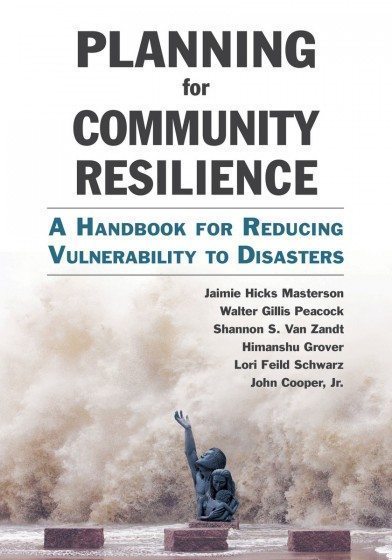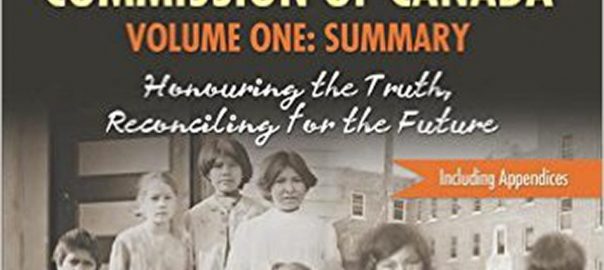A review of Planning for Community Resilience: A Handbook for Reducing Vulnerability to Disasters, by Jamie Hicks Masterson, Walter Gillis Peacock, Shannon S. Van Zandt, Himanshu Grover, Lori Felid Schwarz, and John T. Cooper Jr. 2014. ISBN: 9781610915854. Island Press, Washington. 256 pages. Buy the book.
Resilience certainly is the buzzword of our time, symptomatic of an era of greater uncertainty and risk, and more regular shocks and crises. But as some commentators argue, the more or less universal uptake of resilience is itself a way of framing challenges that fits with a neoliberal agenda—placing the burden of action on individuals, households, and communities, while deflecting attention from the systemic failings of states and markets that are contributing to emerging vulnerabilities and risks. It is in this context that guidebooks about how to operate at the community level need to be considered.
An engaged process, as outlined in this book, could be a catalyst for a type of planning that addresses some of the core systemic (and political) concerns that resilience building tends to neglect.
Guides, toolkits, and toolboxes proliferate. There is clearly a need. It’s often difficult to know what, exactly, resilience means. Indeed, there have been a number of campaigns recently to encourage people to explain, in their own terms, what resilience means to them. There is a danger here that resilience will come to mean all things to all people and, as such, that it means everything and nothing. There are several attempts now available to guide us through building resilience, with much of this focused on the level of community.
Here, two powerful buzzwords—resilience and community—come together, yet often with little critical reflection. Both words combine an everyday meaning with positive connotations, as well as a more technical meaning from social and ecological theory. When they enter the realm of public policy, they can support a whole range of (sometimes) unexpected policy narratives; both resilience and community are often associated with narratives of standing on one’s own feet, of being stoical in the face of shocks and crises. As such, they, can deflect attention from the very causes of crisis, and the need for more transformative—often political—change, and the role of the state in providing support.
Community resilience building opens a conceptual and discursive quagmire; there is clearly a need for how to steer some meaningful action. Working one’s way through the maze of resilience theory, discourse, and practice is a challenge—perhaps there is a need for a guidebook to the guidebooks. Each set of tools seems designed to offer a unique perspective, with innovative approaches that mark them out from others that are available. But it is often unclear whether what is being proposed is anything new.
 With the proliferation of climate related shocks and crises, building resilience in the face of shocks and crises surely is a good thing, and any contribution to helping us make sense of what this might mean and how it might be achieved is certainly welcome. Planning for Community Resilience: A Handbook for Reducing Disasters is a comprehensive book, which is quite an achievement in less than 200 pages.
With the proliferation of climate related shocks and crises, building resilience in the face of shocks and crises surely is a good thing, and any contribution to helping us make sense of what this might mean and how it might be achieved is certainly welcome. Planning for Community Resilience: A Handbook for Reducing Disasters is a comprehensive book, which is quite an achievement in less than 200 pages.
The book begins with a compelling explanation of the emerging threat, pulling no punches with the introductory chapter: “The Era of Catastrophes.” It then outlines an overall approach to resilience preparedness, a seven-step process that forms the structure of the book itself: Organize; Connect; Assess; Envision; Prioritize; Implement; Monitor, Evaluate; and Update. This is the basis of the substance of the book, with a series of exercises that are intended to guide planners, citizens, researchers, and other concerned stakeholders through a community-scale resilience building process. Part of the motivation here appears to be to overcome current disaster management practices that emphasize structural infrastructure solutions over soft solutions that might focus on ecological responses, or those that address underlying planning weaknesses.
Yet the book is also based on extensive research and analysis, and a thorough post-mortem of disasters, particularly the experience of Galveston, Texas. Presenting such research insights in an accessible how-to guidebook poses a difficult balance to strike, with the risk that the expectations of two very different readerships might not be met.
For me, reading Planning for Community Resilience: A Handbook for Reducing Disasters has been something of a journey to another world. Sitting in one of Asia’s mega-cities as we are about to approach a drought, only a few years after devastating floods, the book provided insight into a planning context in which actual planning appears to occur; where legislation operates with land use planning, zoning, and building codes; where communities have access to public finance, with rights and the capacity to organize; and where there is a degree of accountability and transparency. I couldn’t help but marvel at the differences, while also wondering about the applicability of the handbook for other parts of the world, outside of the United States.
This is clearly unfair. The handbook targets a part of the world I know little about. But nonetheless, I found myself wondering how more marginalized, poorer communities, and local authorities with limited capacity and financial resources, might begin a process of community resilience building, while also facing other demands and pressures. In some ways, the handbook is too comprehensive—it makes the task seem overwhelming, in a way that is all too familiar. With so much to do, so much detailed analysis, mapping, and consultation, where would one begin? Are there shortcuts, or stripped down approaches that could be applied and modified?
Throughout the book, the emphasis is on building a process of public engagement as the basis for community resilience. Such an emphasis is very much welcome. The authors highlight the importance of public participation and inclusive processes, while also pointing to the necessity of understanding and planning around community dynamics and differentiation. Too much of resilience writing presents it as a rather managerial, technical exercise for experts often overlooking the need to make choices, each with winners and losers. It is less common to find such insights into how to bridge the technical dimensions with a process that can mobilize stakeholders, and put the choices in the public domain.
They do so by introducing concepts of assets and capabilities, drawing on the sustainable livelihoods literature that is probably more familiar to the development and humanitarian world than to urban planners. This is welcome. Going back to established concepts grounded in the political economy of vulnerability that have often been neglected in the sphere of resilience takes some of the burden off resilience theory, which is notoriously weak at addressing issues of power. Rather than mold resilience to something for which it is not designed, it makes more sense to complement resilience theory with such approaches as sustainable livelihoods. Framing the book in this way allows the authors to ‘pull together the pieces,’ including the social, ecological, political, and institutional dimensions, of community resilience. The authors have done an impressive job of assembling a great deal of material from different disciplines. It is rare to come across planners presenting a handbook that also talks about issues of power and participation, critical—but often overlooked—elements of community engagement and action.
Early on, the authors delve into explaining what resilience is. However, this is balanced by being largely based on an array of definitions, with an interesting set of boxes spread over several pages offering definitions from different authors and disciplines. This provides a useful resource for students of resilience, but it is not clear what the value of the boxes is within the overall purpose of the handbook. As important as it is to define resilience as a term, greater effort is needed in laying out the theory of resilience. There is an intellectual history to resilience thinking that tends to be neglected in favor of attempts to capture its richness in simple definitions. Fortunately, the authors then point to some of the risks of applying these kinds of definitions to what they term ‘social systems,’ because there may well be something so fundamentally wrong with the ‘system’ itself, that building resilience really requires transformation of that system. For a handbook on community resilience, this is an important argument, but one that has obvious dimensions of politics, power, rights, and justice.
In addition to discussing definitions of resilience, the book would have benefited from outlining some of the key concepts of resilience theory and how they might be applied to community-scale actions. For example the book would have benefited from a deeper discussion of core urban systems—water, food, energy, transport, waste—and an explanation of critical theory, which underscores the dependence cities on infrastructure and technology; issues of interconnected and interlinked dependencies; cascading impacts of shocks and crises beyond location; and the increasingly complex institutional arrangements that these require. Similarly, including information about the characteristics of resilience, such as safe-failure, redundancy, and diversity might have helped structure some of the later sections of the book. It is in this area of characteristics of resilience that much of what is new about resilience theory becomes more meaningful, providing insight into what it would mean to reimagine and reshape urban systems around managing potential failure as a result of shocks and crises; rather than managing around unrealistic hopes for fail-safe urban systems.
The meat of the handbook takes the reader through a lengthy step-by-step journey of planning. There is a huge amount of information guiding us through each step, interspersed with tables, photographs, and graphics to make it more accessible. This is a thorough section but requires some patience to work one’s way through. It details a method that is enormously data-intensive, requiring a range of data and information, analytical tools, and processes. The authors seem aware that this might be overwhelming and try to point to ways in which data needs can be met.
The book is targeting a readership of planners, citizens, and researchers that have access to a wealth of resources, and a planning process that is based on evidence. I am not convinced that this is the situation in communities across the U.S. It certainly is not the case in most parts of the world. The book could have been strengthened by considering the case of marginalized communities in the U.S. itself, and how such a public process as they outline could be implemented.
There is clearly a balance that needs to be struck between the need for data and information and the need for a process that is public and driven by citizens as much as by planners. If approached from a more aspirational perspective, the book has value for those working in other parts of the world. Even from a baseline of limited (and largely inaccessible) data, an engaged process as outlined in this book could itself be a catalyst for a different type of planning—for generating publicly owned data and opening public spaces that can be empowering and that can foster innovation, and thereby addressing some of the core systemic (and political) concerns that resilience building tends to neglect.
Richard Friend
Bangkok







Leave a Reply